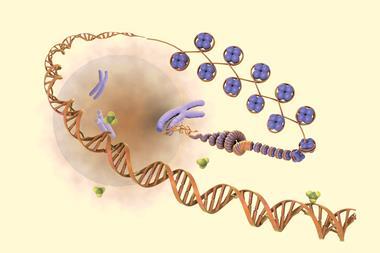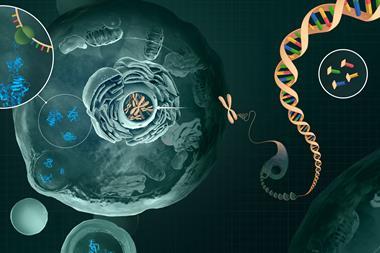Waves of self-catalysing chemical reactions can be controlled using short strands of DNA
Chemical reactions proceeding far from their equilibrium state can generate complex spatial patterns in which concentrations of the reacting and diffusing ingredients vary from place to place. So-called reaction-diffusion processes like this are thought to underlie many natural patterns, from animal markings to coloured bands in minerals. Now, a team working in France and Japan have used strands of DNA to control the parameters of the molecular interactions so that the patterns they make might be tailored to order1. As well as helping fundamental investigations of these chemical reactions, the method might be used to fix useful arrangements of molecules in new devices and materials.
The key to these pattern-forming systems is autocatalysis: some of the reactants catalyse their own formation, creating a positive-feedback process that enables small differences in concentration to blossom into large ones. A balance between runaway feedback that consumes the ingredients and molecular diffusion that replenishes them can lead to oscillations, radiating chemical waves and stationary patterns.
Now, a team led by André Estevez-Torres of the Laboratory of Photonics and Nanostructures at CNRS in France has manipulated such chemical patterning in a reaction-diffusion process that involves artificial strands of DNA. Here autocatalysis comes from the growth of an 11-nucleotide strand (A) into a doubled 22-nucleotide strand on a template with a complementary base sequence (T), catalysed by a DNA polymerase enzyme. A second enzyme then nicks the 22-mer in half, releasing two molecules of A.

Co-author Yannick Rondelez of the University of Tokyo and his colleagues previously used this DNA-based reaction-diffusion scheme to make a molecular system with reaction dynamics mimicking that of a model of the interactions between populations of predators and their prey2, for which parallels with oscillating chemical reactions were first drawn over a century ago.3 The group showed that this system can generate two-dimensional concentration waves, including some with the complex spatial patterns such as spirals familiar from other oscillating reactions.
Reaction control
To control these patterns, one must be able to vary the two key parameters of the process: the rates of reaction and of diffusion. The former is quite straightforward: the rate of autocatalysis of A can be varied simply by changing the concentration of the template strand T. Controlling the diffusion is more challenging. The researchers do it by slowing down T with a cumbersome appendage. They attach a cholesteryl group to the end, which, being fatty and hydrophobic, accumulates a shell of surfactants when these are added to the mixture. This reduces the rate of diffusion by a factor of up to 2.7; Estevez-Torres says that in subsequent experiments they have now slowed it by fourfold. Using gels instead of solutions, where a network of polymer chains retards diffusion, they hope to do better still. ‘We need a factor 10 to be able to get very exciting patterns,’ he says.
‘I find this direction to be extremely exciting,’ says DNA nanotechnology expert Erik Winfree of the California Institute of Technology in the US. ‘I think it is only a matter of time before molecular programming evolves to the point where a naive user can design complex pattern-formation processes.’
‘An even more interesting prospect would be for the spatial patterning to trigger polymerization or self-assembly reactions, and thus control materials synthesis,’ Winfree adds. Estevez-Torres says that the team is already exploring such possibilities, perhaps ‘to create some kind of primitive programmable or self-healing matter’.
References
A S Zadorin et al, Phys. Rev. Lett. 2015, DOI: 10.1103/PhysRevLett.114.068301
A Padirac et al,J. Am. Chem. Soc, 2013, DOI: 10.1021/ja403584p
A J Lotka, J. Phys. Chem.14, 271, 1910












No comments yet